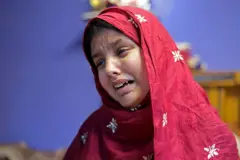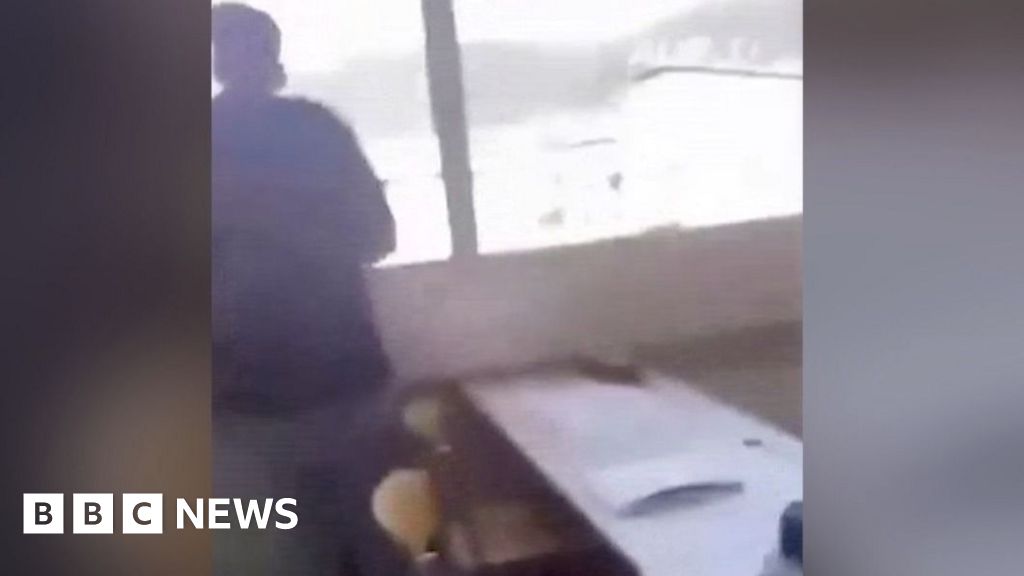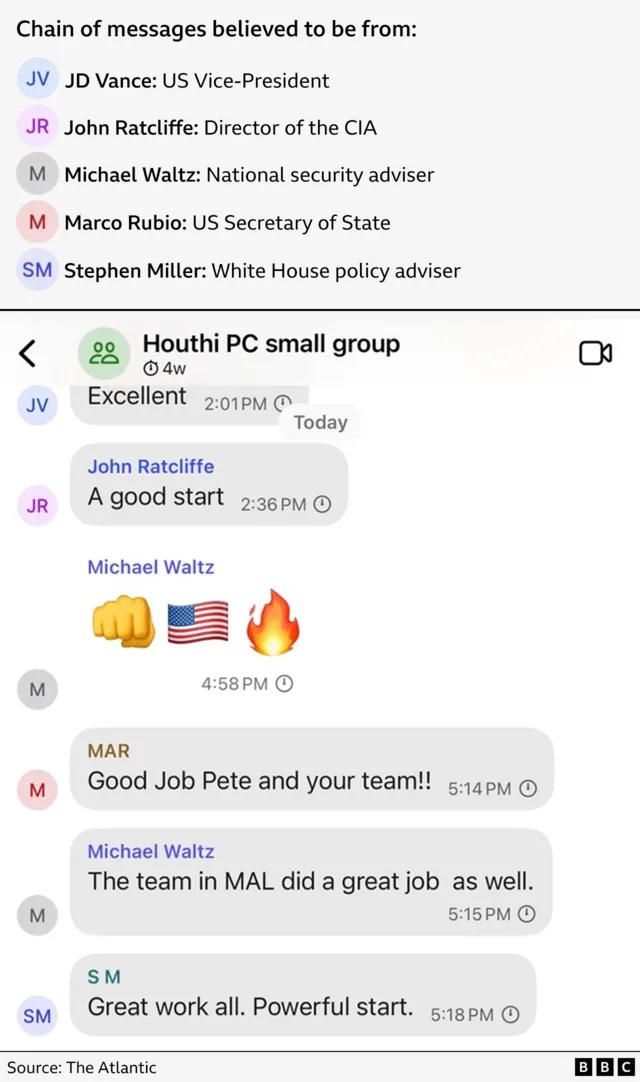BBC News
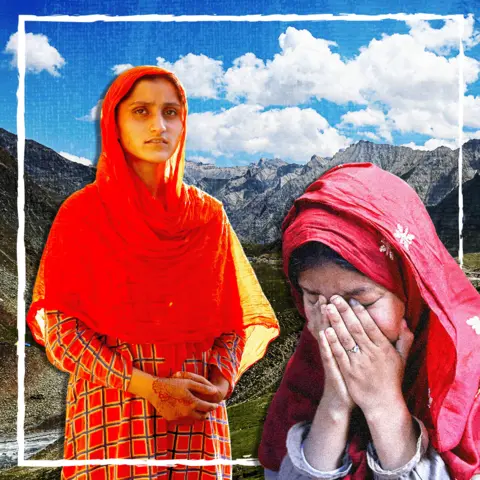 BBC
BBCSixteen-year-old Nimra stood outside, rooted to the spot, as the Indian missiles that had woken her a moment ago rained down on the mosque a few metres from her house in Pakistan-administered Kashmir. She watched one tear the minaret off the top of the building. But she failed to realise she, too, had been struck – in the chest.
When the family reached the relative safety of her aunt’s house nearby, someone turned on a phone torch. “My aunt gasped. There was blood on my frock. It was pink and white but now soaked in red. I hadn’t seen it before.” Again they ran. “I was running but my hand was pressed on my chest the whole time. I didn’t want to take it off. I thought if I let go, everything inside me would come out.” A piece of shrapnel was lodged near her heart, she later discovered.
A few hours later, in Poonch, Indian-administered Kashmir, a different family was dodging shelling which Pakistan had launched in response to India’s missile strikes.
“When the firing began, everyone ran for their lives – children clinging to their parents in fear,” said MN Sudhan, 72. “Some families managed to leave for Jammu in their vehicles. We also decided to escape. But barely 10 minutes into our journey, a shell landed near our vehicle. The shrapnel tore through the car. My grandson died on the spot.”
“Our future was shattered at that [very] moment,” Mr Sudhan said of 13-year-old Vihaan’s death. “Now we’re left with nothing but grief. I have witnessed two wars between India and Pakistan, but never in my life have I seen shelling as intense as this.”
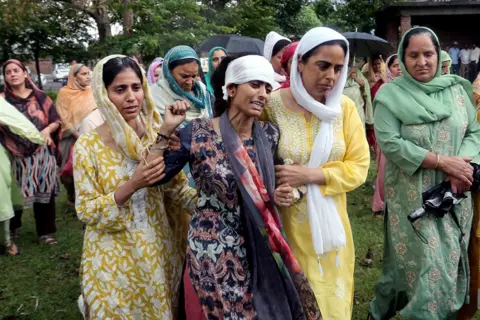 Reuters
ReutersNimra and Vihaan were among many of the villagers caught up in the deadliest attacks for several years in a decades-long conflict between two of the world’s nuclear powers – India and Pakistan. Both sides administer the Himalayan region in part but claim it in full. Both governments deny targeting civilians, but BBC journalists in the region have spoken to families caught up in the violence.
The strike that injured Nimra was part of India’s armed response after a militant attack killed 26 people – mostly Indian tourists – last month at a beauty spot in India-administered Kashmir. Police there claimed militants included at least two Pakistan nationals. Pakistan has asked India for evidence of this, and has called for an independent inquiry into who was behind the attack.
What followed was four days of tit-for-tat shelling and drone attacks, intensifying each day and culminating in missile strikes on military bases, which threatened to tip over into full-blown conflict. Then, suddenly, a ceasefire brokered by the US and other international players on 10 May brought the two nuclear powers back from the brink.
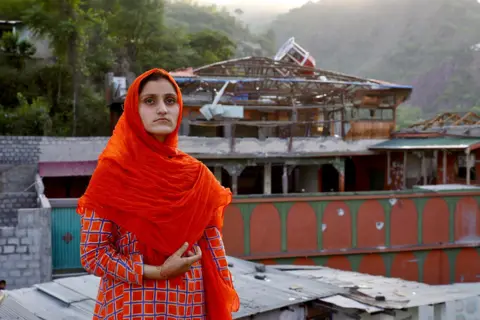 TASEER BEYG / BBC
TASEER BEYG / BBCFamilies on both sides of the Line of Control (LoC) – the de facto border in Kashmir – told us they had had loved ones killed and property destroyed. At least 16 people are reported to have been killed on the Indian side, while Pakistan claims 40 civilian deaths, though it remains unclear how many were directly caused by the shelling. We also heard from Indian and Pakistani government insiders about the mood in their respective administrations as the conflict escalated.
In Delhi’s corridors of power, the atmosphere was initially jubilant, an Indian government source told the BBC. Its missile attacks on targets in Pakistan-administered Kashmir and in Pakistan itself – including the Bilal Mosque in Muzaff arabad, which India claims is a militant camp, though Pakistan denies this – were deemed a success.
“The strikes… were not limited to Pakistani-administered Kashmir or along the Line of Control,” an Indian government source told the BBC. “We went deep – even into the Pakistani side of Punjab, which has always been Pakistan’s red line.”
But the Pakistani military had been prepared, a source from the Pakistan Air Force told the BBC. Days earlier, the Pakistani government said it was expecting an attack.
“We knew something was coming, and we were absolutely ready,” one officer said, speaking on condition of anonymity. He said Indian fighter jets approached Pakistani territory and the air force was under instructions to shoot down any that crossed into its airspace or dropped a payload.
Pakistan claims to have shot down five Indian jets that night, something India has remained silent on.
“We were well prepared, and honestly, we were also lucky,” the source said – his account repeated by two other sources.
But Mr Sudhan, Vihaan’s grandfather, said there had been no warning to stay indoors or evacuate. “Why didn’t they inform us? We, the people, are caught in the middle.”
It is likely that no evacuation orders had been issued because the Indian government needed to keep the military strikes confidential, though the local administration had, following the April militant attack, directed locals to clean out community bunkers as a precautionary measure.
A day after the initial missile strikes, Thursday, both sides launched drone attacks, though they each accused the other of making the first move.
India began to evacuate thousands of villagers along the Indian side of the LoC. Just after 21:00 that evening, the Khan family in India-administered Kashmir decided they must flee their home in Uri, 270km (168 miles) to the north of Poonch. Most of their neighbours had already left.
But after travelling for just 10 minutes, their vehicle was struck by shrapnel from a shell, fatally injuring 47-year-old Nargis. Her sister-in-law Hafeeza was seriously injured. They headed to the nearest hospital, only to find the gates locked.
“I somehow climbed the hospital wall and called out for help, telling them we had injured people with us. Only then did the staff come out and open the gate. As soon as they did, I collapsed. The doctors were terrified by the ongoing shelling and had closed everything out of fear,” Hafeeza said.
Hafeeza’s sister-in-law Nargis is survived by six children. The youngest daughter Sanam, 20, said the first hospital they went to was not equipped to help, and as they headed to another, her mother died of her injuries.
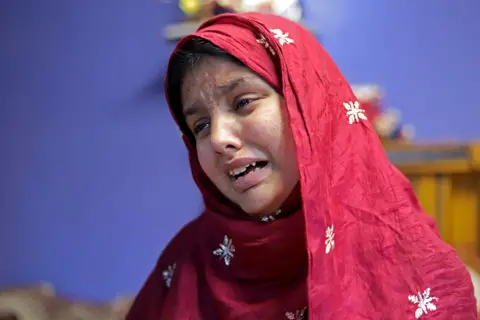 SYED SHAHRIYAR / BBC
SYED SHAHRIYAR / BBC“A piece of shrapnel had torn through her face. My clothes were soaked in her blood… We kept talking to her, urging her to stay with us. But she passed away on the way.”
Since a ceasefire agreement between India and Pakistan in 2021 there had been relative peace in the region, locals told the BBC. For the first time in years, they had been able to live normal lives, they said, and now this sense of security was destroyed.
Sanam, who lost her mother, said: “I appeal to both governments – if you’re heading into war, at least secure your civilians. Prepare… Those who sit in comfort and demand war – they should be sent to the borders. Let them witness what it really means. Let them lose someone before their eyes.”
Sajjad Shafi, the representative for Uri in the regional government, said he had acted as promptly as possible.
“The moment I got the news that India has attacked, I got in touch with people and started moving them out.”
After two days of attacks and counter attacks, the Indian government source said there was now a “clear sense in… power corridors that things were escalating but we were ready.
“We were ready because India had spent the last 10 years acquiring and building strategic military assets – missiles, warheads and defence systems.”
On the international stage, there had been consternation that the tensions would not be de-escalated by the US, despite its diplomatic overtures during India and Pakistan’s previous Kashmir clashes.
US Vice President JD Vance said a potential war would be “none of our business”.
This statement came as no surprise, the Indian government source told the BBC. At that stage, “it was clear the US didn’t want to get involved”.
By the following day, Friday, shelling had become more intense.
Muhammed Shafi was at home with his wife in Shahkot village in the Neelum Valley, Pakistan-administered Kashmir, on the LoC.
The 30-year-old was standing in the doorway, just a few steps away from where his son was playing; his wife standing in their courtyard.
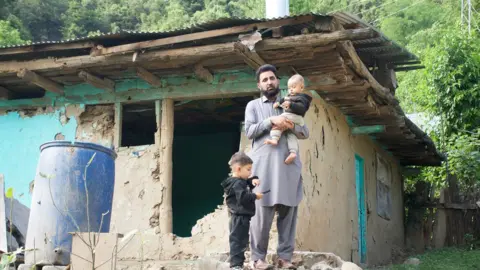 TASEER BEYG / BBC
TASEER BEYG / BBC“I remember looking up and seeing a mortar shell coming from a distance. In the blink of an eye, it struck her. She didn’t even have time to scream. One second she was there, and the next, she was gone. Her face… her head… there was nothing left. Just a cloud of smoke and dust. My ears went numb. Everything went silent. I didn’t even realise I was screaming.
“That night, her body lay there, right in our home. The entire village was hiding in bunkers. The shelling continued all night, and I stayed beside her, weeping. I held her hand for as long as I could.”
One of those in a bunker was his niece, 18-year-old Umaima. She and her family were holed up in the shelter for four days, on and off, in brutal conditions.
“There were six or seven of us packed into it,” she said. “The other bunker was already full. There’s no place to lie down in there – some people stood, others sat. There was no drinking water, no food,” with people shouting, crying and reciting prayers in the pitch black.
Also in a bunker, in the Leepa Valley, Pakistan-Administered Kashmir – one of the most militarised and vulnerable valleys in the region – was Shams Ur Rehman and family. It is Shams’s own bunker, but that night he shared it with 36 other people, he said.
Leepa is surrounded on three sides by the LoC and Indian-administered territory, so Shams was used to living with cross-border tensions. But he was not prepared for the complete destruction of his house.
He left the bunker at three in the morning to survey the scene.
“Everything was gone. Wooden beams and debris from the house were scattered everywhere. The blast was so powerful, the shockwave pushed in the main wall. The metal sheets on the roof were shredded. The entire structure shifted – by at least two inches.
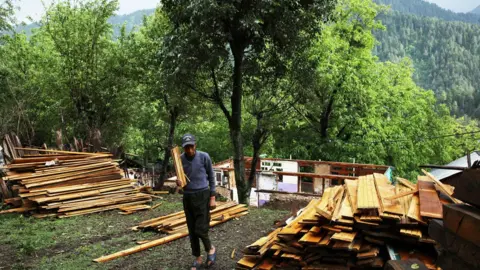 TASEER BEYG / BBC
TASEER BEYG / BBC“A house is a person’s life’s work. You’re always trying to improve it – but in the end, it’s all gone in seconds.”
Four hours later, back in the Neelum Valley, Umaima and her family also emerged on Saturday 10 May to a transformed landscape.
“We came out of the bunker at seven in the morning. That’s when we saw – nothing was left.”
As Umaima surveyed the ruins of her village, India and Pakistan’s forces that day were trading ever more destructive blows – firing missiles at each other’s military installations, which both sides accused the other of instigating.
India had targeted three Pakistani air bases, including one in Rawalpindi – the garrison city that houses the Pakistan Army’s General Headquarters.
“This was a red line crossed,” said one Pakistani officer. “The prime minister gave the go-ahead to the army chief. We already had a plan, and our forces were desperately ready to execute it… For anyone in uniform, it was one of those unforgettable days.”
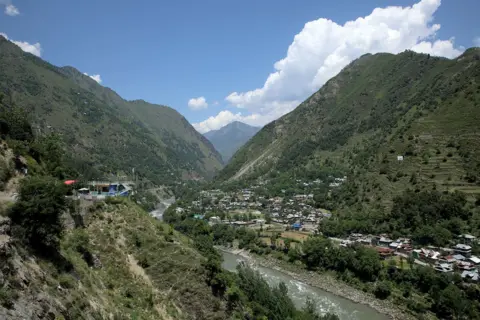 TASEER BEYG / BBC
TASEER BEYG / BBCPakistan hit back at Indian military installations. On the diplomatic front, this was seen as a moment to highlight the issue of Kashmir on the international stage, an official in the Pakistan foreign office told the BBC.
“It was non-stop. Endless meetings, coordination, and back-to-back calls to and from other countries for both foreign minister and then the prime minister. We welcomed mediation offers from the US, the Saudis, the Iranians, or anyone who could help de-escalate.”
On the Indian side, the Pahalgam attack on 22 April had already prompted External Affairs Minister S Jaishankar to speak to at least 17 world leaders or diplomats, including UK Foreign Secretary David Lammy and Russian Foreign Minister Sergey Lavrov. In most of these conversations, he has tweeted, the emphasis had been on the “cross-border terrorist attack” and focused on building a case to hold the perpetrators accountable for the attack.
Then, on Saturday afternoon local time, in the aftermath of the latest missile exchanges, came a diplomatic breakthrough out of nowhere. US President Donald Trump took to social media to reveal that a ceasefire had been agreed.
“After a long night of talks mediated by the United States, I am pleased to announce that India and Pakistan have agreed to a FULL AND IMMEDIATE CEASEFIRE.
“Congratulations to both Countries on using Common Sense and Great Intelligence,” he wrote on social media platform Truth Social.
India has since downplayed Washington’s role in the ceasefire and it has rejected that trade was used as a lever to achieve this.
Behind the scenes, US mediators, diplomatic backchannels and regional players, including the US, the UK and Saudi Arabia, had proved critical in negotiating the climbdown, experts say.
“We hit Pakistani strategic bases deep inside their territory and that must have worried the US,” the Indian government source believes.
In Pahalgam, the site of the militant gun attack that sparked the crisis, the search is still on for the perpetrators.
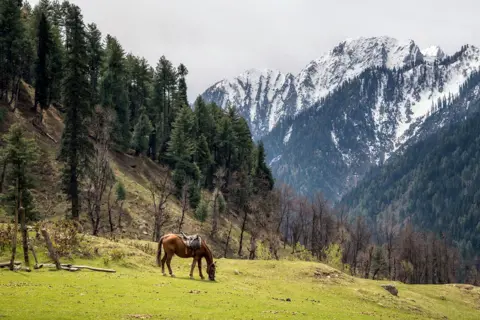 Getty Images
Getty ImagesVinay Narwal, a 26-year-old Indian Navy officer, was on his honeymoon in Pahalgam when he was killed. He had got married just a week before the attack.
A photo of Vinay’s wife Himanshi, sitting near her husband’s body following the attack, has been widely shared on social media.
His grandfather Hawa Singh Narwal wants “exemplary punishment” for the killers.
“This terrorism should end. Today, I lost my grandson. Tomorrow, someone else will lose their loved one,” he said.
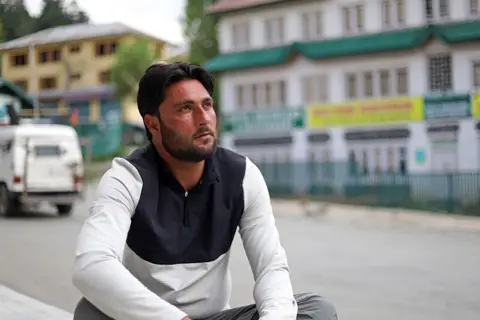 SYED SHAHRIYAR / BBC
SYED SHAHRIYAR / BBCA witness to the attack’s aftermath, Rayees Ahmad Bhat, who used to lead pony treks to the beauty spot where the shootings took place, said his industry was now in ruins.
“The attackers may have killed tourists that day, but we – the people of Pahalgam – are dying every day since. They’ve stained the name of this peaceful town… Pahalgam is terrorised, and its people broken.”
The attack was a huge shock for a government which had begun to actively promote tourism in stunningly picturesque Kashmir, famed for its lush valleys, lakes and snow-capped mountains.
The source in the Indian administration said this might have lulled Delhi into a false sense of security.
“Perhaps we got carried away by the response to tourism in Kashmir. We thought we were over a hump but we were not.”
The four-day conflict has once again shown how fragile peace can be between the two nations.
Additional reporting by Vikas Pandey in Delhi
